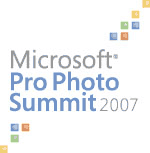Microsoft Pro Photo Summit - A Recap & Review
 There was a lot to take in at the Microsoft Pro Photo Summit this past week. It was the second annual event, and my first time in attendance.
There was a lot to take in at the Microsoft Pro Photo Summit this past week. It was the second annual event, and my first time in attendance.
I give the Summit high marks for their program. A great deal of ground was covered over those two days -- it certainly could have been extended to a third. Microsoft's Tim Grey hosted the event, with interspersed insights from Kostas Mallios, Senior Director of the Rich Media Group at Microsoft, as well as David Vaskevitch, CTO of Microsoft. This proved to be a heavy-hitting team leading the effort, and they brought in Kevin Gilbert, of Blue Pixel to moderate - a daunting task for anyone, but one that Kevin seemed to handle quite well.
I did not, however, have the historical insight of the previous year's summit. One point that more than one person made, who did have that insight, was to ask about product and metadata integration issues during the IPTC/metadata panels, "why aren't you people working together on these issues" and "what have you done about this since last year", because, seemingly, it was the same organizations/corporations up there last year that were saying the exact same things, and nothing has changed amongt them, was the sentiment that I heard more than once. I do know that the PLUS Coalition is doing as much as it can, but they can only do so much - it's like a one-legged man in an ass-kicking contest.
Apparently, last year, it was highly recommended that there be more panels, and Microsoft listened. They had many many of them. This year, while I didn't think that break-out sessions were warranted, others did. My argument against them is that I didn't want to miss any of the panels/subjects, and I'd rather stay an extra day than miss out on any of the session contents.
One of the tools they used - to great effect - was the "3 minutes to WOW" concept, some scripted, some last-minute presentations were:
- The absolutely surreal PhotoSynth is something that you must see to believe.
- Peter Krogh showed his RapidFixer tool that allows you to make almost all of the CameraRAW adjustments to your images from within Bridge, and the latest incarnation steps it up a notch or two from it's first showing back in CS2. It's a time-saver well worth what little he's charging for it.
- Evan Nisselsen, who was on an early panel on Day 1, followed the panel on "Images Everywhere", here he took the 3 minutes to WOW to demonstrate how Digital Railroad's member archives were used to great effect with Universal News and Sport's coverage of a terrorist incident at the Scotland's Glasgow Airport, where the "little guy" beat the big corporations, using DRR's Marketplace to deliver the images. A WOW response from the audience ensued, clearly impessed.
- Grover Sanschagrin of PhotoShelter stepped up to the plate and hit one out of the proverbial park demonstrating how you could search for an image of Barry Bonds, select it, price out the license using the pricing model from FotoQuote, and download it. Sanschagrin did the search and pricing so fast that he'd not even used up two minutes before saying he was done, WOW-ing them with the obvious ability to make good money, and with over 8,000 subscibers that many more people charting their own course is going to be good for our community.
- Also making an exceptional showing was Tricia Gellman Holmes, of Livebooks. She demo'd their new video series, which is worth a look, especially the first one on Michael Jang. I had previously been skeptical of Livebooks because of their inability to appear in the search results, but doing a search sports photographer on Google yields Brad Mangin, a Livebooks user, at position 3 on Google, and Sports Photographer on Yahoo in #2. While Livebooks isn't a panacea for ranking, it's clearly not a hinderance, as people (including me) suggested in the past. So, it's definately worth a look as one good solution if you're not going the full customization route.
Microsoft clearly has stepped up to a plate, at a game it's been absent from. Adobe and Apple have been photo-industry leaders, while Microsoft has been focused elsewhere. When they introduced Windows Media Photo as a file format back in November of 2006, which has now been re-branded as HD Photo (*.hdp) (more information on it here), many people scoffed at it. What could be better than JPEG? Well, JPEG-2000 was, and HD Photo is supposed to better than both. As Microsoft continues to evolve and grow it's role amongst professional photographers (and thus, into acceptance by pro-sumers and product manufacturers) people will be much more likely to listen and less likely to scoff. This is a good thing, and I presume, one of the many reasons that Microsoft established this Summit. Let's see what next year will bring. I can't wait.
Please post your comments by clicking the link below. If you've got questions, please pose them in our Photo Business Forum Flickr Group Discussion Threads.
 A few weeks ago I wrote
A few weeks ago I wrote 